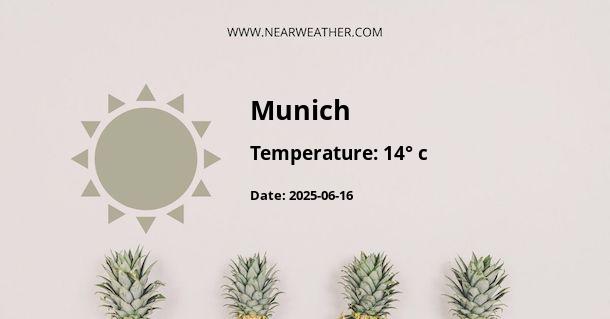Understanding the Climate and Weather Patterns of Landkreis München (Munich District), Germany
Landkreis München, the district surrounding the bustling Bavarian capital of Munich, Germany, experiences a temperate oceanic climate with continental influences. This climate translates to warm summers, cold winters, and precipitation evenly distributed throughout the year. The proximity to the Alps to the south also affects the weather, bringing increased rainfall and occasional föhn winds — warm, dry winds that can rapidly change the weather. In this detailed overview, we'll delve into the different aspects of the region's climate and provide a comprehensive look at the weather patterns throughout the year.
Seasonal Climate Overview
The climate in Landkreis München can be broken down into four distinct seasons, each with its unique characteristics:
- Spring: As the snow melts away, the region welcomes spring with a gradual rise in temperatures from March to May. This period sees a combination of rainy days and an increasing number of sunny spells.
- Summer: From June to August, temperatures warm up significantly, creating perfect conditions for enjoying the Biergartens and outdoor activities. Occasional heat waves and thunderstorms are common during these months.
- Autumn: September to November is a transitional time with crisp air and falling leaves. The weather turns cooler and rain becomes more frequent, leading to a picturesque autumn landscape with its renowned Oktoberfest festivities.
- Winter: December to February is the coldest season, marked by frosty temperatures, potential snowfall, and fewer daylight hours. It's a magical time in the region with Christmas markets and winter sports activities.
Temperature Ranges and Averages
Temperature fluctuations in Landkreis München vary throughout the year. Data from meteorological services indicate the following average temperature ranges:
| Season | Average High (°C) | Average Low (°C) |
|---|---|---|
| Spring | 8 - 19 | 0 - 7 |
| Summer | 20 - 25 | 10 - 15 |
| Autumn | 9 - 19 | 1 - 8 |
| Winter | -1 - 4 | -5 - 0 |
Precipitation Patterns
Landkreis München receives a fair amount of precipitation year-round, with slight variations:
"The annual rainfall in Landkreis München averages around 900-1000mm, with the summer months typically being the wettest due to convective precipitation." - Meteorological Institute Munich
The following are the monthly precipitation averages:
| Month | Average Precipitation (mm) |
|---|---|
| January | 40 |
| February | 36 |
| March | 50 |
| April | 70 |
| May | 100 |
| June | 130 |
| July | 140 |
| August | 120 |
| September | 80 |
| October | 60 |
| November | 60 |
| December | 50 |
Extreme Weather Conditions and Climate Challenges
While Landkreis München's climate is generally mild, it is not without its climate challenges. Winters can see heavy snowfall and cold waves that severely impact traffic and day-to-day life. In contrast, summers can experience severe thunderstorms that pose a risk of flash floods, especially in the alpine regions. Heatwaves are also becoming more frequent due to global climate change, pushing the infrastructure and public health systems to adapt and respond effectively.
Wind Patterns and Sunshine Hours
Wind conditions in Landkreis München tend to be calmer, with the exception of the föhn wind phenomenon. However, general wind speeds are moderate throughout the year. Sunshine duration varies, with the region enjoying longer daylight during the summer. The following table outlines the average sunshine hours per season:
| Season | Average Sunshine Hours |
|---|---|
| Spring | 160 hours per month |
| Summer | 220 hours per month |
| Autumn | 150 hours per month |
| Winter | 80 hours per month |
Microclimates and Topographical Impacts
The topography of Landkreis München, being in the foothills of the Alps, means that there are microclimates affecting local weather conditions. This can lead to variations in temperature and precipitation in localized areas, especially in higher elevations compared to the lower-lying Munich metropolitan area.
Adapting to the Climate for Travel and Living
Understanding the local climate is crucial for anyone planning to travel to or live in Landkreis München. Regular updates from the German Weather Service (DWD) and reliable weather apps help residents and visitors prepare for any upcoming weather events. Building standards and infrastructure in Landkreis München also reflect the need for weather resilience, with insulated homes for the winter and advanced drainage systems to handle heavy rains.
Future Climate Projections
Long-term projections introduce a degree of uncertainty, but trends suggest an increase in average temperatures and more frequent extreme weather events in Landkreis München. Studies indicate potential shifts in precipitation patterns, with drier summers and wetter winters expected. These changes will necessitate further adaptation strategies in agriculture, urban planning, and water management throughout the district.
Conclusion: Importance of Climate Awareness in Landkreis München
Climate and weather influence daily life, seasonal activities, and long-term planning in Landkreis München. Awareness of the patterns and trends allows for smarter building practices, preparedness for extreme weather events, and an appreciation for the region's varied and beautiful weather conditions. As climate change continues to affect global weather systems, staying informed and adaptable is more important than ever.
A - Munich's Latitude is 48.051392 & Longitude is 11.642220.
A - Weather in Munich is -2° today.
A - Climate Conditions in Munich shows light snow today.
A - Humidity in Munich is 93% today.
A - Wind speed in Munich is 6.44 km/h, flowing at 283° wind direction. today.
